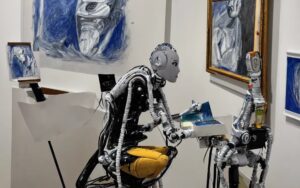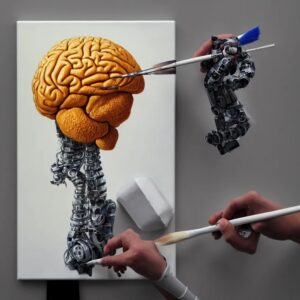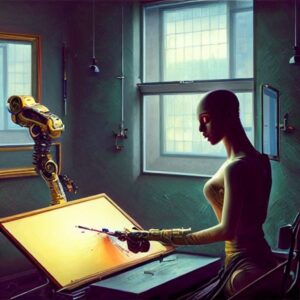
16 May Reimagining Artistry: Empowering Artists in the Age of AI
Artificial intelligence (AI) has become a topic of much discussion in recent years, with many experts predicting that it will have a profound impact on the workforce. While AI has the potential to create new jobs and increase productivity, there is growing concern that it may also take away jobs from people. In this article, we’ll explore how AI is taking away jobs from people and what we can do about it.
What is AI?
AI refers to the use of machines to perform tasks that would normally require human intelligence, such as problem-solving, decision-making, and learning. AI is powered by algorithms, which are sets of rules and instructions that guide machines in their decision-making processes.
The Impact of AI on the Workforce for Artists
The rise of artificial intelligence (AI) is having a profound impact on artists across the world. With AI becoming increasingly sophisticated, many artists are now finding themselves competing against machines that can create art that is eerily similar to human-made creations.
AI is impacting the job market for artists in several ways, leading to concerns about job opportunities. Automation plays a significant role by taking over repetitive tasks such as photo editing, graphic design, and music composition. AI algorithms can quickly generate designs, apply filters, and create music based on predefined parameters, reducing the need for human intervention.
Additionally, the availability of stock content, templates, and pre-designed elements provided by AI-powered platforms diminishes the demand for commissioned artwork. AI can also emulate artistic styles by analyzing existing artworks, resulting in AI-generated pieces that appeal to certain audiences. Online marketplaces that connect artists with clients may utilize AI algorithms to match clients with pre-selected artists or even recommend AI-generated content, reducing opportunities for artists to showcase their work.
Lastly, demographic shifts and changing audience preferences influenced by the rise of AI and digital experiences may impact traditional art forms, leading to a potential decline in demand for physical paintings or sculptures. These factors highlight the need for artists to adapt, collaborate, and explore new avenues to maintain their relevance and creative contributions in the evolving landscape shaped by AI.

So, What’s our solution to the matter?
You may not be aware of this but the Director of FILMARTIST came up with a unique solution in order to stand ahead of this matter and prevent job loss with the rise of AI. We call it the Paris Equation. Named after our Founder and Director Paris Zheng.
Paris mentions that the rise of AI is inevitable and instead of being afraid of this phenomenon we just need to know how to navigate through it.
In order to stand out you need to sharpen 3 skills otherwise known as the 3 C’s. These are listed as follows
- Creativity – Train your ideas, they will be what get you further in any industry
- Challenges – Know how to overcome obstacles and not be afraid to take risks
- Communication – Be able to know how to talk with others
As artificial intelligence (AI) continues to grow and become more prevalent in various industries, it’s essential to have skills that differentiate us from machines. Creativity, challenges, and communication skills are crucial in this regard. Creativity allows us to approach problems in unique and innovative ways that AI might not be able to replicate. Challenges help us develop resilience and adaptability, enabling us to stay ahead of AI’s capabilities. Effective communication skills allow us to collaborate and work in teams, making us more efficient and productive than machines that lack the ability to empathize or understand human emotions. Therefore, having these skills is crucial to stand out in a world increasingly dominated by AI.
With the rise of AI, the job market is becoming more competitive, and individuals who possess strong soft skills are more likely to stand out and succeed. Developing these skills not only makes you a more valuable employee, but it can also enhance your personal and professional growth.

What more can Artists do about this?
With the rise of AI, artists have a variety of options and opportunities to explore. Here are a few ways artists can navigate this situation:
- Embrace AI as a tool: Artists can adopt AI as a creative tool to enhance their artistic process. AI technologies can assist with generating ideas, creating visual effects, automating repetitive tasks, or even collaborating with the artist to create unique pieces. By leveraging AI tools, artists can unlock new possibilities and push the boundaries of their art.
- Explore AI-generated art: Artists can actively engage with AI-generated art by using algorithms and machine learning techniques to generate unique artworks. They can experiment with generative adversarial networks (GANs), style transfer algorithms, or other AI models to create innovative and unconventional pieces. This allows artists to blend their creativity with the capabilities of AI, resulting in fascinating collaborations.
- Address the social and ethical implications: As AI continues to evolve, artists can play a crucial role in raising awareness about the social, cultural, and ethical implications of AI. They can use their art to explore and critique topics such as privacy, bias, surveillance, or the impact of automation on society. By bringing these issues to the forefront, artists can encourage dialogue and reflection on the implications of AI.
- Maintain the human touch: While AI can assist and inspire artists, it’s essential to preserve the human touch in art. Artists can focus on creating work that reflects their unique perspectives, emotions, and experiences. They can emphasize the qualities that distinguish human artistry, such as intuition, subjectivity, and the ability to convey deep emotions. By embracing their individuality, artists can create art that resonates with audiences on a human level.
- Adapt and collaborate: Artists can adapt to the changing landscape by collaborating with AI experts, technologists, and scientists. By teaming up with AI specialists, artists can gain insights into the capabilities and limitations of AI, opening up new avenues for creative expression. Collaborations can lead to interdisciplinary projects, exhibitions, or performances that merge art and technology in exciting ways.
- Explore new mediums and formats: AI opens up possibilities for artists to explore new mediums and formats. Virtual reality (VR), augmented reality (AR), interactive installations, or online platforms provide artists with fresh canvases to experiment with. By embracing these technologies, artists can create immersive and engaging experiences that captivate audiences in novel ways.

Remember, the rise of AI doesn’t diminish the value of human creativity. Rather, it presents an opportunity for artists to evolve, adapt, and explore new frontiers in the ever-changing artistic landscape. However, there are also concerns that the rise of AI could lead to a loss of creativity and originality in the art world. Some worry that if machines become too good at replicating human-made art, there will be no need for human artists at all. Others worry that artists may become too reliant on AI and lose touch with the unique, human qualities that make art so special. Despite these concerns, it seems likely that AI will continue to play an increasingly important role in the world of art. As technology advances and machines become more sophisticated, artists will need to adapt and find new ways to use AI to their advantage. Ultimately, it will be up to individual artists to decide how best to integrate this new technology into their work and to ensure that it continues to serve as a tool for creativity and expression, rather than a threat to it.

